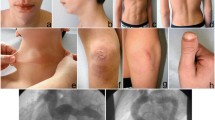Abstract
Brachydactyly short-stature hypertension syndrome, also known as hypertension-with-brachydactyly (HTNB) syndrome, is a rare autosomal dominant disorder that was first described by Bilginturan and colleagues in 1973. Many familial cases of HTNB have been reported, but the first sporadic case of this condition was published only recently. This article describes a case of HTNB syndrome in a 16-year-old boy. Although Doppler ultrasonography of the kidneys and renal arteries showed normal findings, magnetic resonance angiography showed an aberrant right posterior inferior cerebellar artery, early bifurcation of the left renal artery, and irregularity and stenosis of the inferior dominant branch of this artery. The patient’s father was in chronic renal failure of which the primary pathology was unknown. We speculate that the described case is the second documented sporadic case of HTNB syndrome. This disorder should be included in the differential diagnosis of patients with short stature and hypertension of unknown aetiology. Such individuals should be carefully examined for brachydactyly and for cerebral–cerebellar and renal vascular malformations.



Similar content being viewed by others
References
Schuster H, Wienker TF, Bahring S, Bilginturan N, Toka HR, Neitzel H, Jeschke E, Toka O, Gilbert D, Lowe A, Ott J, Haller H, Luft FC (1996) Severe autosomal dominant hypertension and brachydactyly in a unique Turkish kindred maps to human chromosome 12. Nat Genet 13:98–100
Bilginturan N, Zileli S, Karacadag S, Pirnar T (1973) Hereditary brachydactyly associated with hypertension. J Med Genet 10:253–259
Online Mendelian Inheritance in Man, OMIM (TM). Johns Hopkins University (Baltimore, MD, USA). MIM Number: 112410.http://www.ncbi.nlm.nih.gov/omim/
Schuster H, Wienker TF, Toka HR, Bahring S, Jeschke E, Toka O, Busjahn A, Hempel A, Tahlhammer C, Oelkers W, Kunze J, Bilginturan N, Haller H, Luft FC (1996) Autosomal dominant hypertension and brachydactyly in a Turkish kindred resembles essential hypertension. Hypertension 28:1085–1092
Litwin M, Jurkiewicz E, Nowak K, Kosciesza A, Grenda R, Malczyk K, Kosciesza I (2003) Arterial hypertension with brachydactyly in a 15-year-old boy. Pediatr Nephrol 18:814–819
Naraghi R, Geiger H, Crnac J, Huk W, Fahlbusch R, Engels G, Luft FC (1994) Posterior fossa neurovascular abnormalities in essential hypertension. Lancet 344:1466–1470
Naraghi R, Schuster H, Toka HR, Bahring S, Toka O, Oztekin O, Bilginturan N, Knoblauch H, Wienker TF, Busjahn A, Haller H, Fahlbusch R, Luft FC (1997) Neurovascular compression at the ventrolateral medulla in autosomal dominant hypertension and brachydactyly. Stroke 28:1749–1754
Chitayat D, Grix A, Balfe JW, Abramowicz JS, Garza J, Fong CT, Silver MM, Saller DN, Bresnick GH, Giedion A, Lachman RS, Rimoin DL (1997) Brachydactyly short-stature hypertension (Bilginturan) syndrome: report on two families. Am J Med Genet 73:279–285
Bahring S, Nagai T, Toka HR, Nitz I, Toka O, Aydın A, Muhl A, Wienker TF, Schuster H, Luft FC (1997) Deletion at 12p in a Japanese child with brachydactyly overlaps the assigned locus of brachydactyly with hypertension in a Turkish family. Am J Hum Genet 60:732–735
Bahring S, Rauch A, Toka O, Schroeder C, Hesse C, Siedler H, Fesus G, Haefeli WE, Busjahn A, Aydin A, Neuenfeld Y, Muhl A, Toka HR, Gollasch M, Jordan J, Luft FC (2004) Autosomal-dominant hypertension with type E brachydactyly is caused by rearrangement on the short arm of chromosome 12. Hypertension 43:471–476
Author information
Authors and Affiliations
Corresponding author
Additional information
This study was presented as a poster at the European Human Genetics Conference in Munich, Germany, on 12–15 June 2004
Rights and permissions
About this article
Cite this article
Derbent, M., Baskın, E., Ağıldere, M. et al. Brachydactyly short-stature hypertension syndrome: a case with associated vascular malformations. Pediatr Nephrol 21, 390–393 (2006). https://doi.org/10.1007/s00467-005-2111-6
Received:
Revised:
Accepted:
Published:
Issue Date:
DOI: https://doi.org/10.1007/s00467-005-2111-6




